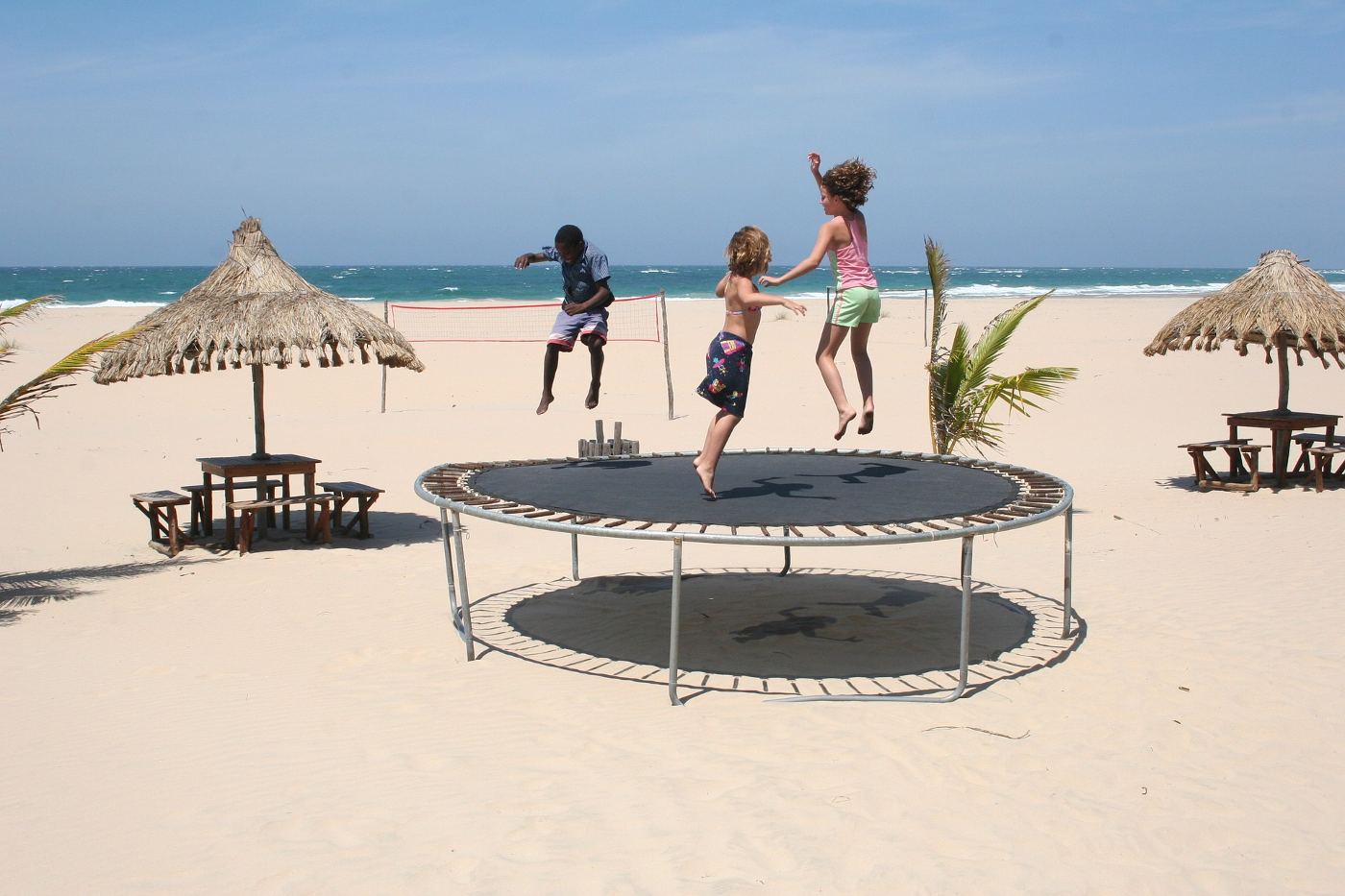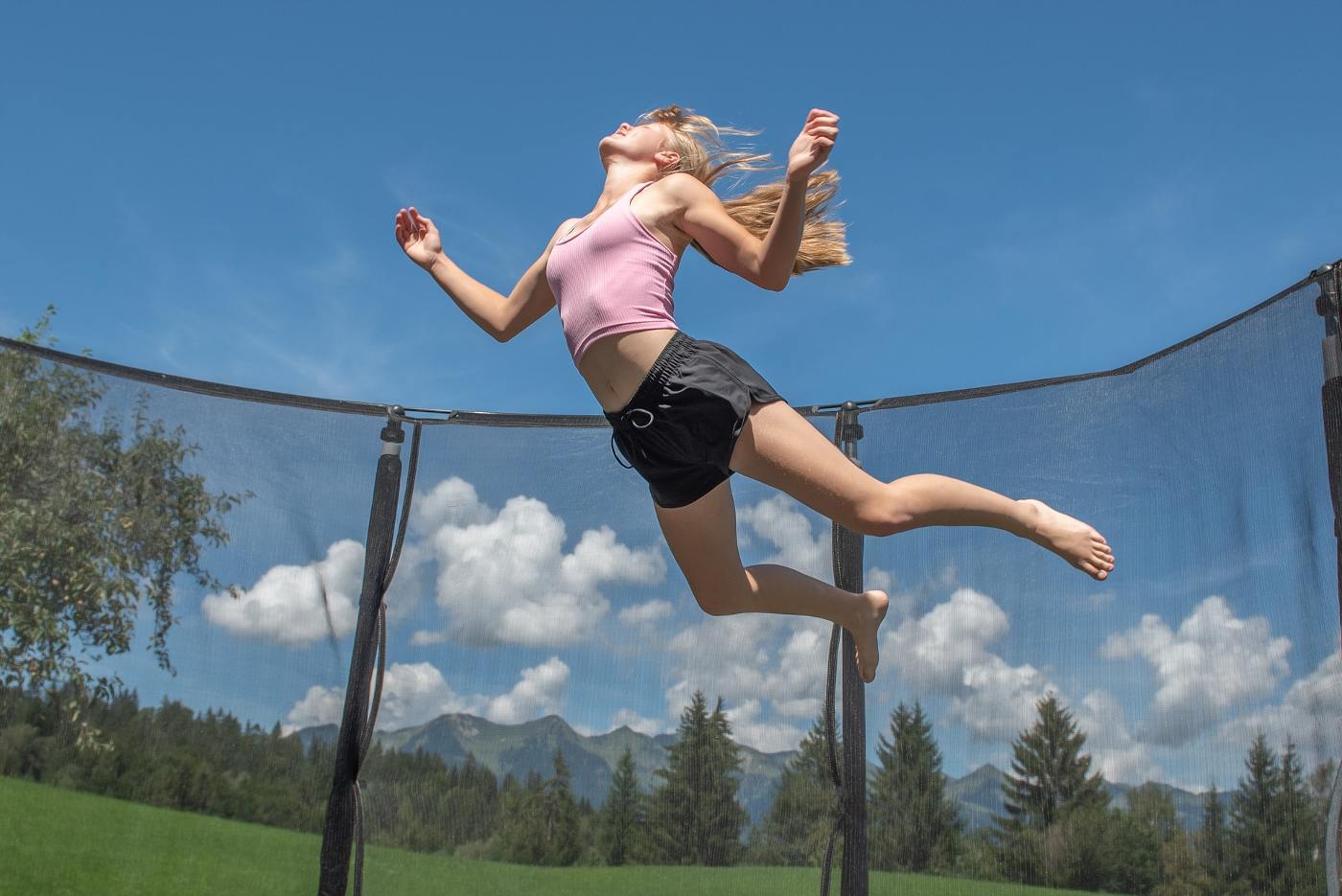Jumping on a trampoline is a fun and engaging activity for people of all ages and it can also provide a great workout for those who are looking to stay active. However, owning a trampoline comes with its fair share of responsibilities, and one of the most important ones is ensuring that the trampoline is securely anchored to the ground.
This might seem like a minor detail, but a trampoline that’s not properly secured can be a hazard to both the people using it and the surrounding property. An unsecured trampoline can easily be swept away by strong winds, causing damage to itself and anything in its path and even potentially injuring anyone nearby.
Luckily, several effective methods are available if you’re looking to learn more about how to keep a trampoline from blowing away. From anchoring kits and wind stakes to sandbags and enclosure netting, there’s a solution for every situation and environment.
In this comprehensive guide, we’ll explore various techniques and tools that you can use to keep your trampoline grounded and safe, no matter the weather conditions. As you read on, you’ll find valuable information and expert advice about how to hook down a trampoline to keep it from blowing away.
Disclosure: This page contains affiliate links. As an Amazon Associate, we earn a commission from qualifying purchases.
How to keep a trampoline from blowing away in the wind
Trampolines are a delightful addition to any backyard, but they can also become airborne projectiles when they’re not properly secured. To learn how to keep a trampoline from blowing away, it’s crucial that you understand the factors that contribute to this phenomenon. Armed with this knowledge, you’ll be better equipped to protect your trampoline from the forces of nature.
3 factors that contribute to trampolines blowing away

Wind and weather conditions
The wind is one of the most obvious factors that can cause a trampoline to blow away. Strong gusts, storms or even sustained high winds can generate enough force to lift a trampoline off the ground and send it flying. In some cases, trampolines have been known to fly hundreds of feet or even further, causing extensive damage to property and posing a significant risk to public safety.
Trampoline design and materials
The design and materials of a trampoline can also contribute to its likelihood of blowing away. Lightweight materials and large surface areas can make trampolines more susceptible to being lifted by the wind. Moreover, the shape of the trampoline can play a role in how easily it catches the wind. For example, a round trampoline may be more resistant to the wind than a rectangular one, as the latter will have a larger surface area exposed to that wind, making it more prone to being lifted.
Incorrect installation or lack of anchoring
Trampolines that aren’t properly installed or anchored are at a higher risk of blowing away. Failing to secure your trampoline to the ground can leave it vulnerable to even moderate winds. A lack of proper anchoring can also make your trampoline unstable for users, posing a safety hazard for anyone who decides to jump on it. To keep your trampoline safe and secure, following the manufacturer’s guidelines for installation and anchoring is essential.
6 essential tools and accessories
A variety of tools and accessories are available to help you effectively secure your trampoline against strong winds and other weather-related threats. Next, we’ll explore the essential tools and accessories you can use to keep your trampoline from blowing away and ensure that it remains a safe and enjoyable feature in your backyard.
Let’s dive into the world of trampoline anchoring and learn exactly how to keep a trampoline from blowing away.
Trampoline anchors
Trampoline anchors are specifically designed to keep your trampoline in place by attaching it securely to the ground. These anchors usually consist of a corkscrew or auger-like stake that’s screwed into the ground, with a strap or cord attached to the trampoline frame. The stake provides a strong hold in the soil, while the strap or cord ensures that the trampoline remains tethered to the ground.
Ground stakes
Ground stakes, also known as pegs, are another option for securing your trampoline. These stakes are typically made of metal and are hammered into the ground at an angle to provide additional stability to the trampoline. Once the stakes are in place, they can be attached to the trampoline frame with straps or cords, thereby creating a secure connection between the trampoline and the ground.
Straps and cords
Straps and cords are essential to any anchoring system, as they connect the trampoline frame to the ground anchors or stakes. These straps are typically made of heavy-duty materials, such as nylon or polyester, to ensure durability and strength. It’s essential to choose straps and cords that are resistant to weather and UV exposure so they’ll maintain their effectiveness over time.
Wind stakes
Wind stakes are specially designed stakes that will offer additional stability to your trampoline in windy conditions. These stakes are usually longer and more robust than standard ground stakes, which gives them a stronger hold in the ground. Wind stakes can be used in conjunction with other anchoring systems or as a stand-alone solution for added peace of mind during windy weather.
Sandbags and weights
If you’re looking for a non-invasive way to secure your trampoline, sandbags and weights can be excellent options. These can be placed around the trampoline’s legs, which will help weigh it down and prevent it from lifting off the ground during strong winds. While sandbags and weights may not offer the same level of security as anchoring systems, they can still be a valuable addition to your trampoline safety arsenal.
Enclosure netting
Though it’s not specifically designed for anchoring, enclosure netting can provide an added layer of protection against the wind. Enclosure nets help reduce the amount of wind that can pass through a trampoline, acting as a windbreak and reducing the likelihood that your trampoline becomes airborne. Additionally, enclosure netting adds an extra layer of safety for jumpers by preventing falls and collisions with the trampoline frame or springs.
7 steps to hook down a trampoline to keep it from blowing away

Securing your trampoline is crucial to ensuring safety and preventing damage to your property. Here, we’ll run through our step-by-step guide to how to hook down a trampoline to keep it from blowing away. By following these steps, you can confidently choose the right anchoring system for your needs, install it properly and take additional precautions to keep your trampoline safe and secure.
Choose the right anchoring system
The anchor system you choose will primarily depend on your environment, your ability to install a particular system and your budget.
Assess your specific needs and environment
Before selecting an anchoring system, it’s essential to assess your specific needs and the environment in which your trampoline is located. Consider factors such as the soil type, the frequency of high winds and the size and shape of your trampoline. These factors will help you determine the most suitable anchoring system for your situation.
Compare different anchor types
Once you’ve assessed your needs, it’s time to compare the various types of anchoring systems available, such as trampoline anchors, ground stakes and wind stakes. Consider the strengths and weaknesses of each system, and choose the one that offers you the best combination of security, ease of installation and affordability.
Install the anchoring system
No matter what anchoring system you’ve chosen, cleaning and leveling the ground and following your trampoline manufacturer’s instructions are essential to the process.
Prepare the ground
Before installing your anchoring system, clear any debris and level the ground around your trampoline. This will ensure that the anchors have solid contact with the ground and can provide maximum stability.
Attach the anchor system to the trampoline
While following the manufacturer’s instructions, attach the anchor system to your trampoline. This may involve attaching straps or cords to the trampoline frame, securing ground stakes or wind stakes through the trampoline’s legs, or connecting the trampoline to corkscrew-style anchors.
Secure the trampoline to the ground
With the anchor system attached to the trampoline, it’s time to secure it to the ground. Depending on the type of anchoring system you’ve chosen, this may involve screwing the anchors into the ground, hammering ground stakes at an angle, or placing sandbags or weights around the trampoline’s legs.
Additional precautions
It’s best to inspect your trampoline about once a week to keep it as safe as possible, and during this time, it’s a good idea to think about new security methods that may be available to you.
Regularly check and maintain the anchoring system
To ensure that your trampoline remains secure, it’s essential to regularly check and maintain the anchoring system. Inspect the straps, cords and anchors for signs of wear, and replace any damaged components as needed. Make sure the anchors remain firmly in the ground, and adjust them if necessary.
Consider using multiple securing methods
For added peace of mind, you may want to consider using multiple securing methods to keep your trampoline from blowing away. For instance, you could combine ground stakes with sandbags or use both trampoline anchors and wind stakes. By employing multiple securing methods, you can create extra stability and reduce the risk of your trampoline taking flight during high winds.
Ready for any weather
If you follow this step-by-step guide about how to keep a trampoline from blowing away, you can rest assured that your trampoline will remain safe, secure and ready for fun-filled jumping sessions, no matter the weather.
image 1: Pixabay; image 2: Pixabay; image 3: Pixabay

